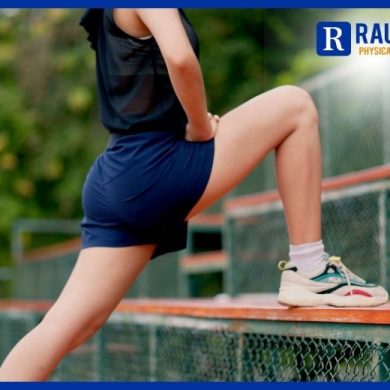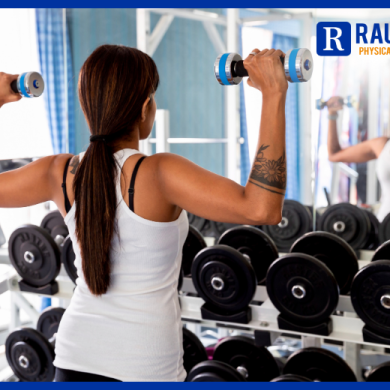Tight hips can subtly impact your daily life and activities, causing discomfort or limiting your movement. Recognizing the signs of restricted hip mobility is key to preventing issues and improving,
How to Activate Your Scapular Muscles to Alleviate Pain
February 20, 2019 2:53 am / Category: Physical Therapy

BY SEAN SWOPES, PT, DPT, CSCS, RAUSCH PHYSICAL THERAPY
As a physical therapist, I find that pain in the shoulder/neck area is one of the more common reasons why patients will come to me for help. While many people will write it off to injury, stress or just part of getting older, I know that often the real culprit behind their painful symptoms is the scapula, or the “shoulder blade.” More importantly, I know that pain relief is as easy as consciously changing how your body moves.
What is My Scapula?
The position of your scapula plays a vital role in how the muscles of our neck and shoulder function, as well as how well they function depending on how it moves with motion and while sitting in resting position. Abnormalities in your “resting position” (a.k.a posture) can cause pesky pain in your shoulders and neck.
While your entire shoulder girdle (comprised of the scapula, humerus, and clavicle) connects your arm to the rest of your body, I like to think of the scapula as the hub for the shoulder and neck. The scapula can move in a variety of motions—up and down, in or out, it can even rotate and tilt—but it’s your posture that dictates how it moves. So if you have bad posture, you’re going to have more pain as your scapula moves.
Activating Your Scapular Muscles to Alleviate Pain
The two most significant posture abnormalities that affect the scapula are downward rotation (caused by overactive rhomboids and levator scapulae) and anterior tilting (caused by the pectoralis minor.) In fact, a 2014 article by the Journal of Orthopaedic & Sports Physical Therapy found that a person who has anterior tilting and decreased upward scapular rotation is predisposed for shoulder and neck pain.
So we all know that poor posture is bad and causes pain, but how can we fix it? Well, I’ve found that the most difficult part about correcting postural changes in the scapular muscles is learning how to properly recruit the muscles of the scapula, often referred to as “stabilizing the scapula.”
[one_half]
INCORRECT SCAPULAR STABILIZATION
[vsw id=”NzzyXUg3zzs” source=”youtube” width=”425″ height=”344″ autoplay=”yes”]
[/one_half]
[one_half_last]
CORRECT SCAPULAR STABILIZATION
[vsw id=”CpvLR6WfvXE” source=”youtube” width=”425″ height=”344″ autoplay=”yes”]
[/one_half_last]
Throughout your body, the more dominant muscles groups have the tendency to “turn on” first and predetermine the movement pattern. In the scapular region, the rhomboids tend to be the strongest muscles, and people will often over-recruit from them, which causes downward (counterclockwise) rotation. This completely abducts the scapula together, which in turn predisposes certain “big” muscles in the neck to be turned on all day.
The job of your big neck muscles is to produce movement, not stabilize your neck or shoulder, so you will often notice the overuse of these muscles by the formation of trigger points or “knots” in the shoulder girdle.
The correct form involves small movements, which allows the scapula to lay flush with the thorax and creates a small amount of posterior (backward) tilting in the scapula.
Three Ways to Correct the Way Your Scapula Moves
Physical therapy is not only about post-surgery rehab or strengthening muscles, it’s also about creating different movement patterns so you can correct dysfunction in the body. The difference between exercise and therapeutic exercise is the intent behind the movement; we need to have conscious control of our body and determine how it moves, as opposed to allowing our body’s muscular restrictions to determine how we move.
Here are three ways you can add intent to your movements throughout your day to change the way your scapula muscles moves and to alleviate discomfort in your shoulders and neck.
1. Practice scapular recruitment. Before you can strengthen the muscles surrounding your scapula, you first have to establish the correct way to position your shoulder girdle. Practice scapular recruitment by gradually pulling your shoulder blade back and down (the downward recruitment should cause a small amount of tilting in a posterior direction.) Once you have the basics down, you can start adding in strengthening exercises, such as rotator cuff strengthening (with a stabilized shoulder blade), 90/90 walkouts, swimmers, etc.
2. EXERCISE 1: Middle and Lower Trapezius Strengthening in an Overhead Position (Without Arm Movement). One of the most common shoulder issues is shoulder impingement, which can be affected by scapular posture. The downward (counterclockwise) rotation of the scapular decreases the subacromial space which increases the chances of impingement.
[vsw id=”4AM2S_E15ac” source=”youtube” width=”425″ height=”344″ autoplay=”yes”]
To perform the exercise, lay on your stomach and recruit the middle and lower trapezius muscles without allowing the deltoids and the rhomboids to over-dominate the movement.
3. EXERCISE 2: Middle and Lower Trapezius Strengthening in an Overhead Position (With Arm Movement). Ready for a challenge? Adding the arm movement makes this exercise a little harder and will help you strengthen those scapular muscles. Just make sure you do this correctly by initiating the movement from the scapula and not overusing your deltoids nor over-activating the upper trapezius muscle. Once you have the movement coordination established, perform the exercise on a stability ball for an added challenge.
[vsw id=”qcloPXdRoXU” source=”youtube” width=”425″ height=”344″ autoplay=”yes”]
 Sean Swopes, PT, DPT, CSCS graduated from CSU Fullerton with a bachelor of science in kinesiology. He went on to receive his doctorate in physical therapy in 2015 from University of St. Augustine, and began his career here at Rausch Physical Therapy and Sports Performance. Sean is also a certified Strength and Conditioning Specialist. As a physical therapist, Sean’s goal is to help his patients understand their musculoskeletal impairments and work together to improve them.
Sean Swopes, PT, DPT, CSCS graduated from CSU Fullerton with a bachelor of science in kinesiology. He went on to receive his doctorate in physical therapy in 2015 from University of St. Augustine, and began his career here at Rausch Physical Therapy and Sports Performance. Sean is also a certified Strength and Conditioning Specialist. As a physical therapist, Sean’s goal is to help his patients understand their musculoskeletal impairments and work together to improve them.
Click to learn more about Sean and our other physical therapists »
Let’s talk! We are here to help. Give us a call for an initial evaluation and assessment. We would love to meet you.
Did you know there’s no prescription needed from a doctor to see us – but we will communicate your progress and treatment to your doctor if you’d like us too!
(949) 276-5401
Disclaimer — All the information that you find on our blogs and social media pages are for informational purposes only and are not intended to be used as your personal professional diagnosis, or treatment. Come and see us for your excellent, personalized care! https://rauschpt.net/






